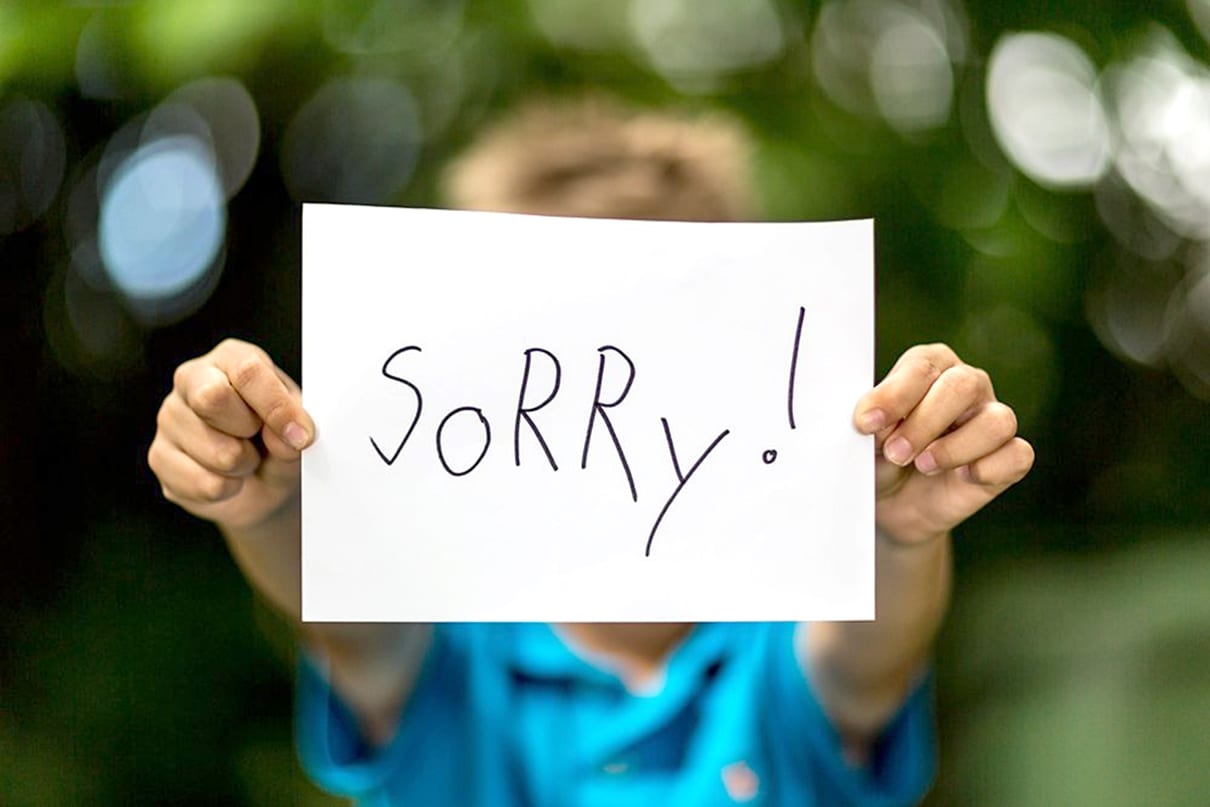Many of our mistakes don't affect those around us, but what about when we hurt someone else, whether intentionally or unintentionally? Should we ignore the mistake and hope it goes away on its own? Should we confront it, no matter how painful, and apologize? How we deal with our mistakes determines the nature of our personalities and how others view us.
One of the most difficult things people face is how to apologize sincerely. It takes a lot of vulnerability to admit our mistakes. However, like anything else in life, when you ignore something painful instead of confronting it, that pain will grow and show up in other parts of your life.
So, how do you apologize effectively? There is no one right way to do this, but there are many ineffective ways to apologize as well. Therefore, we will approach this matter from a perspective that revolves around the regret that characterizes our human nature and our desire to atone for our mistakes that caused harm to others. It is easy to apologize, but your intention must match your words.
Sincere apologizing when making mistakes and expressing your true regret is more difficult. This is what we will discuss in this article. Therefore, we will present an apology method in which your words match your intentions and feelings. It includes four steps to help you ask for forgiveness from those you have wronged and get things back to normal.
This approach focuses on controlling a certain outcome (i.e. repairing a broken relationship) and making peace with yourself so that you can handle the situation. It's very simple. All you have to do is follow the following four steps:
- Apologizing.
- Asking for forgiveness.
- Expressing your gratitude.
- Expressing your love.
These four steps include everything we need to apologize, which we will discuss in detail by dividing them into three specific stages: before, during, and after the apology.
Before apology
1. Apology
What are you apologizing for? Before you start speaking and give in to your pure emotions, it is important to determine what you are apologizing for by following the following four tips:
1.1. Write down the facts
When you begin writing down the facts, avoid making judgments about what happened or assumptions about who was affected by your mistakes. Instead, commit to writing down only the honest facts. Write everything that happened without leaving out any small details.
For example, let's say someone approached you to discuss a problem they were having, and your feedback was overly honest, or you were preoccupied with responding to an email, which caused them to feel offended and leave.
1.2. Write down the role you played in making this mistake
Commit to taking responsibility only for your mistake. Avoid writing about anyone else, even if they caused your mistake, and then simply focus on what you did that contributed to the situation.
Let's see how you can fix the mistake in the previous example of when you were too honest with that person. You could argue that you made a mistake when you offered them the feedback they didn't want to hear, even though you believed it would benefit them. Regarding the second instance in which you failed to give them your whole attention, you can argue that you failed to hear them out when they were in pain and that you made a mistake when you chose to continue working while they were speaking rather than pausing to complete your task or setting your phone aside to give them your whole attention.

1.3. Ask yourself about how you felt when you told yourself the truth
Try the body-sound connection process, which begins by grounding your physical sensations. This process will help you speak honestly and tell the truth objectively, even if you are overwhelmed by strong feelings at the moment. You can apply it through the following steps:
Identify your physical sensations:
Now that you have recalled your mistake by writing it down, you must tune in to your body and ask yourself the following question, “What is the strongest feeling overwhelming my body right now?” Make sure it's just about communicating with your body.
When you prepare yourself to apologize, identifying your feelings helps you solidify how you feel so you can do so successfully.
Determine why you feel these sensations:
Now that you have identified your basic sensations, ask yourself the following question, “What made me feel this way?” Perhaps the answer will be a very simple sentence you have already written. It's the essence of the matter. You can write down something like, "I spoke to my friend inappropriately," or "I ignored my friend when they were in distress."
Identify your emotions:
Now that you know why you have these physical sensations, you must ask the following question: “What emotions do I have about everything that happens?” Some basic emotions you can feel are fear, anger, sadness, disgust, joy, and excitement.
For example, you could write down, “I feel sad because I crossed boundaries with my friend,” or “I feel sad and frustrated because I hurt my friend.”
Determine the ideal outcome you want to achieve:
Your emotions are linked to your desire to achieve a future outcome. So, ask yourself, “Do I have any desires related to everything I have observed?” Examples of intrinsic desires include security, comfort, connectedness stemming from love, and curiosity stemming from the desire for development.
For example, you could write, “I would like to apologize so we can become closer again and improve our relationship.”
1.4. Make sure you actually want to fix things
If you feel unsafe with that person, there is no reason to apologize and reconnect. However, if you feel safe and comfortable with them and want to communicate with them again, you can move to the next step.
During Apologizing
2. Asking for forgiveness
You won't discuss any of the above stages with your friend. You'll admit the hurt you gave them, your part in the issue, and your wish to make things right between you.
It's also crucial that you avoid discussing your friend's role in the issue and stick to discussing the facts of what actually happened, as that is their mission. Using the notes you took in the earlier steps, you can utilize the text that follows:
- “I think <such and such> happened between us.”
- “I think I made a mistake when I < did this and that>.”
- “It made me feel <talk about your emotions>.”
- “Going forward, I would like to <talk about your desire>.”
Let's apply this to our first example when you were too honest with your friend. You can tell them, “I made a mistake when I gave you feedback that you were not interested in hearing, thinking it would be in your best interest.
I felt sad because I crossed my boundaries with you. Moving forward, I would like to offer my apologies and get closer to you again. I confirm that I will ask for your permission in the future before providing any feedback.”
Now let's apply it to the second example when you didn't give the person your full attention. You could say, “I didn't listen to you when you were distressed. I think I made a mistake when I decided to continue working while you were talking instead of finishing what was occupying me or putting my phone away so I could listen to you.
I was sad because I hurt your feelings. Moving forward, I want to apologize, reestablish my connection with you, and promise to pay closer attention going forward. Likewise, I will let you know that I need some time to wrap up some work before I can fully dedicate myself to you.”
Once you tell them this, stop talking about yourself. This is all you have to say to start talking. Listen to them and show your curiosity.
Ask open-ended questions about their experience, such as, “How did you feel about it?” When you speak, let them know that you are listening and acknowledge the impact of what they said.

3. Expressing your gratitude
After you've expressed yourself, allow yourself to see your impact on that person and understand their situation when they show a reaction that might not match what you expected or hoped for. An apology focuses on the other person's experience, not yourself.
Now that you've asked them about their experience, they will likely say things you don't want to hear. This prompts you to defend yourself or even feel angry. A stressful situation like this can also trigger your body’s “fight or flight response.” Sweating, narrowed pupils, tears, or tunnel vision may occur.
All of these things are normal. To avoid this, express your curiosity about their experience and do not listen to them just to be “right,” but rather to communicate and understand each other.
Then, thank them for everything they said and for their presence in your life. Even if they said something you did not like, thank them for telling you the truth about their experience. Doing so is not easy, but it is necessary.
Moving Forward after Apologizing
4. Expressing your love
Suppose you cannot repair your relationship with the other person. This step will arouse your curiosity. How can you repair the relationship and reconnect with them? How will things be different as you move forward? Think of something you can do to communicate again. Express your love, appreciation, and respect for each other.
Make a plan so you can move forward. Write a list of things that make you feel grateful toward this person after reaching the third step. We rarely talk about how much appreciation we have for each other. When we express our gratitude and appreciation to others, we feel a wonderful feeling that surpasses the feeling we experience when we receive that same appreciation from others.
This last step is important not only for the other person affected by your mistakes but also for you to ensure that you are recovering and that you can overcome your mistake.
It is easy for us to beat ourselves up and continue to feel guilty or even ashamed about what we did, even though we feel deep remorse and have previously tried to fix things.
Keep repeating the four steps after you meet. You might also apologize to yourself for hurting yourself unintentionally.
In Conclusion
When we apologize to someone honestly, we have to say everything that is on our minds without holding any expectations of the other person or attempting to influence their behavior. These steps can help us deal with the situation honestly and ultimately heal, even though we have no control over how our apology will be received regardless of how sorry we feel.
If you're having trouble finding the "right" way to reconnect and apologize to someone in your life, we hope these steps will help you take the first step to making things right.






Add comment